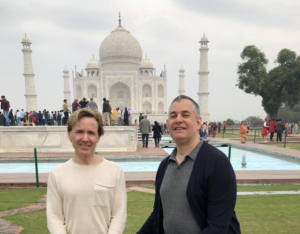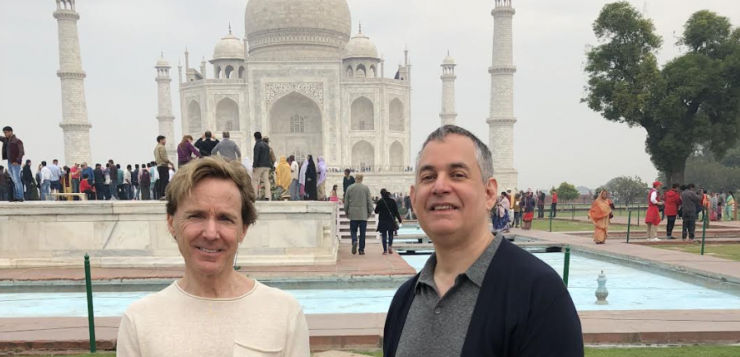
As a queer fiction writer, I’m fascinated by extreme landscapes – those of the heart, and those of the earth.
My novels often take place in gritty, unyielding settings: Hell’s Kitchen, NYC in 1930; rural Arkansas in 1918; industrial St. Louis in 1890; and my latest, which is set in Delhi, India, present day and 1950.
My obsession with these eras and their daunting landscapes, allows me not only to indulge in my cultural and historical curiosities, but also illuminates conflicts— both internally and externally violent— that LGBTQIA people have faced in the past and continue to face today.
In my 2015 novel The Butcher’s Sons, set in 1930’s Hell’s Kitchen (renamed Clinton Hill in the novel), young Adlai must navigate the perils of a clandestine affair with his violent older brother’s best friend, Big Ed. Clinton Hill lives up to its reputation: scrappy and dangerous.
Years later, when I tagged along with my husband on his business trips to Delhi, India in March and October of 2019, I had an inkling that I would write something that took place there. Experiencing Delhi’s frenetic, vibrant energy, intense spiritual devotion, and visible divide between privilege and poverty was a truly visceral, profoundly moving experience. But what really inspired the idea and emotional heart of A Season in Delhi was how I felt being in Delhi as a recently-married gay man. The people I encountered throughout my trip presumptively assigned me the role of wife.
For context, I am a petite man: 5’ 5,” bottle blond, 125 pounds and a lover of designer outfits (cue Thom Browne). I was initially surprised that there did not appear to be judgement of the fact that we were an out gay couple. The clear designation as my role as wife, though, came as a surprise, and felt unshakeable. This was evident the first day we were in Delhi. While my husband and I were shopping at Kahn Market, a saleswoman followed me through the store calling me ‘Mrs.’ and repeating that my husband needed to buy me a bejeweled handbag. Similarly, at a rug emporium, the vendor pulled me aside speaking softly, telling me how much my husband would enjoy making love to me on a new rug, and I could surely convince him to do it.
These experiences, coupled with the fact that I was struggling to get my bearings in a foreign land, stirred age-old feelings of being alone and not aligning with the environment I was in. This sense of isolation and displacement, of being the gay, American ‘wife,’ provided the first emotional kernel for what would become A Season in Delhi.
Indeed, I was there with my husband, and it was his trip; but I had a driver and a lot of free time that I often spent with the Indian wives of my husband’s colleagues. I witnessed a sharp contrast in how the women acted while with their husbands, versus when they were amongst other women. I was clearly embraced by the wives, as they showed me what to buy, where to buy it, and how to best spend my days for the remainder of the trip. The women exhibited a great deal of power when they were by themselves, something I was able to witness.
Granted, these were merely glimpses, but the encounters left an impression, and more and more fragments of a story began to take shape. This led me to create Carol, one of the main characters in A Season in Delhi.
The heart of the story, being a “wife” left alone in a foreign land descending into panic, was a direct result of my experience in Delhi, and my time spent with the Indian women I chummed around with. During the trip, I felt as if the city cast a spell over me, and I had a sensation of being both swallowed up by the enormity of the city, and made a part of its frenetic, exciting and emotionally-charged landscape at the same time. I was able to channel my feeling of loss of self and disorientation directly into the experiences of the novella’s narrator.
The plot of A Season in Delhi involves a gay couple’s journey to India and the narrators’ internal discoveries. I peppered the story with a fictional affair, provoking feelings of guilt, abandonment, and catharsis. But there was something missing. While my stint as a “wife” was short and safe, I wanted to merge the experience of a fictionalized American wife (Carol) living in Delhi in 1950 during the British occupation. I gave Carol a similar set of circumstances: a torrid affair, dangerous choices, and as a result, the dual narrative story lines for A Season in Delhi were born. My narrator, Brant, discovers Carol’s secret journal buried in the backyard of the honeymoon bungalow he and his husband are living in.
 Scott Alexander Hess is the author of seven novels, including Skyscraper, a Lambda Literary Award Finalist, and The Butcher’s Sons, which was named a Kirkus Reviews Best Book of 2015. His pair of novellas in The Root of Everything & Lightning were named best books of 2021 by the St. Louis Librarians. His writing has appeared in HuffPost, Genre Magazine, The Fix, Thema Literary Review, and elsewhere. He also co-wrote Tom in America, an award-winning short film, teaches fiction writing at Gotham Writers Workshop, and curates Hot Lit, an LGBTQIA+ themed monthly newsletter. Originally from St. Louis, Missouri, he lives in New York City with his husband. You can read more about him on his website.
Scott Alexander Hess is the author of seven novels, including Skyscraper, a Lambda Literary Award Finalist, and The Butcher’s Sons, which was named a Kirkus Reviews Best Book of 2015. His pair of novellas in The Root of Everything & Lightning were named best books of 2021 by the St. Louis Librarians. His writing has appeared in HuffPost, Genre Magazine, The Fix, Thema Literary Review, and elsewhere. He also co-wrote Tom in America, an award-winning short film, teaches fiction writing at Gotham Writers Workshop, and curates Hot Lit, an LGBTQIA+ themed monthly newsletter. Originally from St. Louis, Missouri, he lives in New York City with his husband. You can read more about him on his website.





